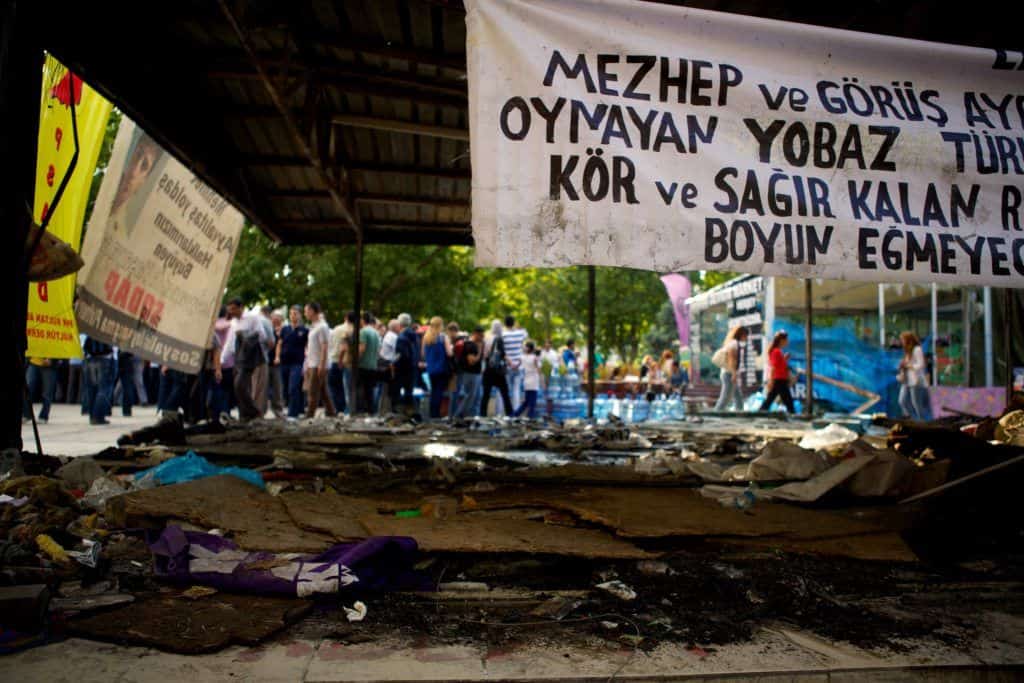Once the violence ended, plans to redevelop the Park were put on hold, the scene of the violence in Istanbul’s busy Taksim Square was paved over and the government set about isolating and dealing with people it identified as key players in stirring up unrest. In particular, the weeks after the protests saw the cull of a number of leading journalists and writers across the newsrooms of Turkish media.
Turkey’s political opposition, the Republican People’s Party (CHP), highlighted these attacks in a document titled, “Turkish government’s retaliation to Gezi,” in which it listed 77 journalists who were either fired or forced to resign, including the leading journalist Yavuz Baydar, who had been the ombudsman for Sabah.
Writing about his case in The Guardian, Baydar voiced criticism of political and internal pressures on the work of journalists. He said, “The country’s journalists are enslaved in newsrooms run by greedy and ruthless media proprietors, whose economic interests make them submissive to Erdoğan.”(1)
It was his criticism – earlier reported in the New York Times – that led to his dismissal from Sabah which at the time was owned by Calik Holding, a company run by Erdoğan’s son-in-law. According to Ercan Ipekci, then President of the Turkish Journalists Union, the number of victims is even higher. He told the EJN that the union had recorded some 85 “well known” cases of journalists who lost their jobs, either through direct dismissals or protest resignations. But he believes the real numbers are higher “probably more than 200 across the country and many of them not well known journalists.” (2)
He said that representatives of political parties contacted editors directly to complain about reporters and writers. Media at national and local levels came under pressure to take action against journalists suspected of supporting the protests.
Another prominent media casualty was columnist Can Dundar who was dismissed from the daily Milliyet, after his columns were not published for three weeks. He was sanguine about his treatment. “I am not the first, and I will not be the last,” he wrote in his blog after his dismissal, which sparked a huge debate in Turkish media. It is the second time Dundar has paid a price for supporting dissidents. Two years ago he was sacked from a TV channel ago for attending a protest over arrested journalists.(3)
Turkey’s public broadcaster TRT dismissed two of its employees and fined another, over social media messages according to the daily Radikal which also said 15 staff members were being investigated, mostly for tweets sent from their personal accounts in support of the Gezi demonstrations.
“The TRT administration has acted as the police, the prosecutor and the judge by illegally inspecting social media accounts of their people. It is clear that both the protection of privacy and freedom of expression were violated here,” the Haber-Sen union said in a statement.(4)
The New York Times on November 14th quoted a leading academic who denied that there was a systematic witch-hunt, but admitted “definitely the government has tightened the screws.” Saban Kardas, a professor at the University of Economics and Technology in Ankara said the actions against journalists and others were “a preventive move, so that these protests don’t happen again.”
According to Akif Beki, a former adviser to Erdoğan and now columnist for the daily Radikal, the pressure in the media is self-imposed. It is the media bosses and not the government who are responsible for the increasing number of sacked journalists. He told the BBC that “it is not like the government asked for these 70-80 journalists to be fired and then media bosses showed them the door”. But he also said the AKP government had failed to rid itself of “old reflexes” towards the media. “They can still perceive criticism as a rejection of their existence. That is why they sometimes overreact.”(5)

Photo Credit: Gregg Carlstrom – Inside Gezi Park – (CC BY-NC 2.0)
However, even in the midst of political interference and internal pressure there were examples of media solidarity and defiance. The Metis book publishing company, for instance, intervened over one of the most egregious examples of self-censorship involving the popular history magazine (NTV Tarih), with a steady circulation of 50,000, which was closed down abruptly by Doğuş Group.
The closure came after the company banned an issue in which journalists reported on the Gezi protests, placing them in their historical context. At least ten people resigned in protest and defiantly published the uncensored edition online. Metis released a book version of the magazine, Gezi Resistance, in October 2013 and announced that income from the book would be donated to a fund to help the families of the five people killed in the Gezi protests.
“We are publishing the Gezi Resistance issue as a document of the linkage between power authorities and media-with the hope that we can leave it to our sons and grandchildren,” Metis wrote at the time.
In a defiant comment Gürsel Göncü, the magazine’s former editor-in-chief, explained what happened: “As NTV Tarih Magazine, we were thinking that we were doing our usual job of depicting events through an original historical lens.(6)
“However, we were wrong,” he said. With the book’s release “We have a publication that will document both Gezi Resistance and media-politics relations in Turkey. History doesn’t freeze, it can’t be frozen. This is just the beginning, we will meet again.”
- http://www.theguardian.com/commentisfree/2013/jul/29/my-‐sacking-‐attack-‐turkish-‐democracy
- Interview with EJN delegation November 20th 2013
- Report in the BBC, November 14th 2013
- Reported In Hurriyet, November 14th 2013
- BBC Report, November 14th 2013
- Report BIA News Desk, October 25th 2013